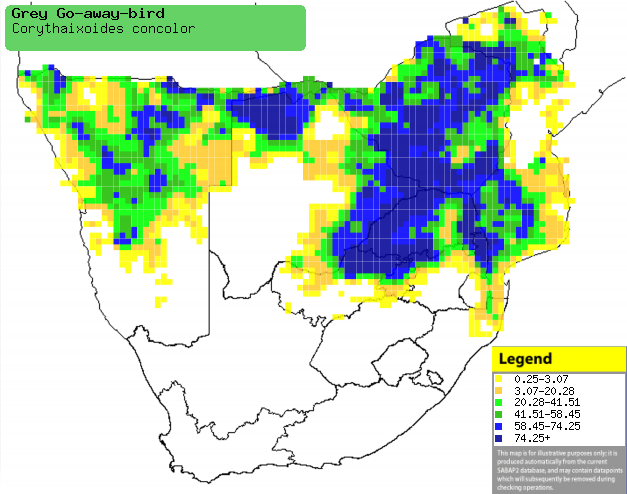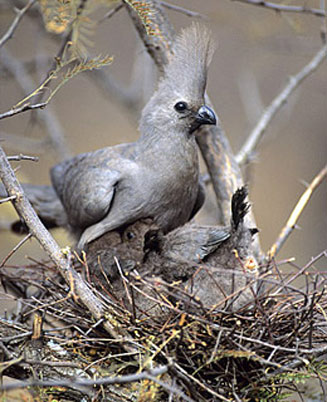Corythaixoides concolor (Grey
go-away-bird, Grey Loerie)
Kwêvoël [Afrikaans]; umKlewu [Zulu];
Nkwe [Kwangali]; Mokowe [North Sotho]; Kuwe, Pfunye [Shona]; Umkluwe [Swazi];
Nkwenyana (generic term for lourie) [Tsonga]; Mokuê [Tswana]; Vale toerako
[Dutch]; Touraco concolore [French]; Graulärmvogel [German]; Turaco-cinzento
[Portuguese];
Life
> Eukaryotes >
Opisthokonta
> Metazoa (animals) >
Bilateria >
Deuterostomia > Chordata >
Craniata > Vertebrata (vertebrates) > Gnathostomata (jawed
vertebrates) > Teleostomi (teleost fish) > Osteichthyes (bony fish) > Class:
Sarcopterygii (lobe-finned
fish) > Stegocephalia (terrestrial
vertebrates) > Tetrapoda
(four-legged vertebrates) > Reptiliomorpha > Amniota >
Reptilia (reptiles) >
Romeriida > Diapsida > Archosauromorpha > Archosauria >
Dinosauria
(dinosaurs) > Saurischia > Theropoda (bipedal predatory dinosaurs) >
Coelurosauria > Maniraptora >
Aves
(birds) > Order: Musophagiformes > Family: Musophagidae
The Grey go-away-bird occurs from coastal Angola
through to southern Africa, where it is common in dry savanna and
suburban gardens. It eats mainly plant products, such as fruit,
flowers, leaves and buds, but it may also eat small invertebrates.
The nest is a flat, flimsy platform, made of interlaced twigs,
normally placed in a thorny tree. It lays 1-4, usually 2-3 eggs
which are incubated by both sexes, for 26-29 days. The chicks stay
in the nest for 18-21 days, leaving before they can fly. At roughly
33 days old, the chicks can feed for themselves, and at roughly 35
days they can fly, becoming fully independent at about 41 days old.
Distribution and habitat
Occurs from Zambia, Malawi and coastal Angola through to
southern Africa, where it is common in northern and central Namibia, northern
and eastern Botswana, Zimbabwe, Mozambique, Swaziland and north-eastern South
Africa. It generally prefers dry savanna,
broad-leaved Burkea (Burkea africana) woodland, dry riverine
woodland and suburban gardens.
|
 |
|
Distribution of Grey go-away-bird in southern Africa,
based on statistical smoothing of the records from first SA Bird Atlas
Project (©
Animal Demography unit, University of
Cape Town; smoothing by Birgit Erni and Francesca Little). Colours range
from dark blue (most common) through to yellow (least common).
See here for the latest distribution
from the SABAP2. |
Call
Predators and parasites
- Predators
- Parasites
- Pseudolynchia canariensis (Hippoboscid fly)
- Paralgoides deformis (feather mite)
- Splendoroffula theresae (feather louse). This genus is
restricted to members of Musophagidae.
- Amblyomma hebraeum (bont tick)
Food
It eats mainly plant products, such as
fruit, flowers, leaves and buds, supplemented with small invertebrates. It
often forages in tree canopies, sometimes descending to the ground to feed on
invertebrates and low-lying plants. The following food items have been recorded
in its diet:
- Plant products
- flowers
- Acacia karroo (Sweet thorn)
- Acacia robusta (Coastal splendid
acacia)
- Burkea africana (Burkea)
- Sclerocarya birrea (Marula)
- Erythrina (coral-trees)
- Bauhinia (bauhinias)
- buds and leaves
- Acacia erioloba (Camel-thorn)
- Acacia robusta (Coastal splendid
acacia)
- Ficus sur (Broom-cluster fig)
- Melia azedarach (Persian lilac)
- Boscia albitrunca (Shepherds-tree)
- the fleshy bases of Aloe zebrina (Zebra
aloe) leaves.
- Medicago sativa (Lucerne)
- cabbage
- lettuce
- fruit
- mistletoes
- Berchemia discolor (Brown ivory)
- Bridelia cathartica (Knobby bridelia)
- Elaeodendron transvaalense (Bushveld saffron)
- Diospyros mespiliformes (Jackal-berry)
- Dovyalis caffra (Kei-apple)
- Euclea (guarri)
- Grewia (grewias)
- Ficus sycomorus (Sycomore fig)
- Ficus abutikifolia (Large-leaved rock fig)
- Lannea schweinfurthii (False-marula)
- Pappea capensis (Jacket-plum)
- Salvadora persica (Mustard tree)
- Strychnos decussata (Cape-teak)
- Strychnos potatorum (Black bitterberry)
- Ziziphus abyssinica (Large jujube)
- Ziziphus mucronata (Buffalo-thorn)
- Xanthocercis zambesiaca (Nyala-tree)
- Melia azedarach (Persian lilac)
- Cotoneaster (cotoneaster)
- cultivated fruit
- guavas
- mulberries
- peaches
- nectar
- Aloe marlothii (Mountain
aloe)
- Aloe globuligemma (Poison
aloe)
- Invertebrates
- Hodotermes mossambicus (Harvester termite)
- Imbrasia belina (Mopane emperor moth)
-
termite alates
Breeding
- The nest is a flat, flimsy platform of
interlaced twigs. It is typically placed 3-10 metres above ground in a thorny tree. In a survey of of 128 different nests, 95 were in
thorny trees, 18 were in non-thorny trees, 12 were in clumps of mistletoe
and 3 were in matted creepers.
 |
|
|
Grey go-away-bird at its nest with chicks,
Sericea farm, South Africa. [photo Warwick Tarboton ©] |
|
- Egg-laying season is year-round, peaking from September-October.
- It lays 1-4, usually 2-3 eggs which are incubated by both sexes for
26-29 days. The incubating bird is very difficult to scare out of its
position. In one situation, the nest was covered in smoke from a grass fire
at the base of the tree, but the incubating bird did not fly off!
- The chicks stay in the nest for 18-21 days, leaving before they can fly.
At roughly 33 days old the chicks can feed themselves, learning to fly a few
days later and becoming fully independent at about 41 days old.
Threats
Not threatened, in fact common across its
distribution.
References
-
Hockey PAR, Dean WRJ and Ryan PG 2005. Roberts
- Birds of southern Africa, VIIth ed. The Trustees of the John Voelcker
Bird Book Fund, Cape Town.
|
